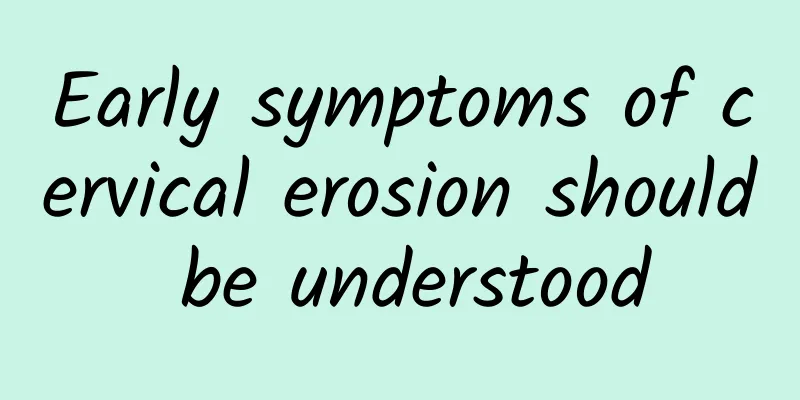What medicine is good for female cervical erosion? What is female cervical erosion?

|
What medicine is good for cervical erosion? Cervical erosion is actually a misunderstanding of a normal cervical manifestation in the past. Now it is replaced by the physiological phenomenon of "cervical columnar epithelium ectopia" in academia. Since cervical erosion is not a disease, how to treat cervical erosion if it is inflamed? Let's learn about it today. What medicine is good for cervical erosion? How to treat inflammation? Cervical columnar epithelial ectopia does not require any treatment. Many current methods for treating cervical erosion are wrong. However, symptomatic cervicitis does need to be treated. Acute inflammation is treated with suppositories, and chronic inflammation can be treated with physical therapy such as laser or freezing. Does cervical erosion require regular check-ups? Regular cervical examination is necessary, not to prevent cervical erosion, but to prevent cervical cancer. What is cervical erosion? There are two different types of cells in the cervix, the ones near the vagina are squamous cells, and the ones near the uterus are columnar cells. The two types of epithelial cells are different in appearance. The central part, which looks a bit like "eroded" cervix, is the appearance after being covered by columnar epithelium, while the relatively smooth outer part of the cervix is the part of the cervix covered by squamous epithelial cells. Before puberty, women's ovarian function is not perfect, estrogen is low, and the columnar epithelium is closer to the inside. After menstruation, the columnar epithelium is affected by estrogen and develops more to the outside. Therefore, more columnar epithelium similar to "erosion" is found during cervical examination. After menopause, women's estrogen levels drop, and the columnar epithelium begins to retreat to the inside. At this time, the "erosion" is no longer visible during examination. Therefore, in essence, the so-called cervical erosion is actually the eversion of the columnar epithelium. Is cervical erosion serious? The so-called first-degree, second-degree, and third-degree cervical erosion in medical textbooks in the past are easy to understand if you look at the real mechanism of "cervical erosion" mentioned above. This is actually the different degrees of eversion of the columnar epithelium after being affected by estrogen, which is a normal physiological phenomenon. Can cervical erosion develop into cancer? The occurrence of cervical cancer is related to infection with human papillomavirus (HpV). Some so-called high-risk types of HPV are prone to precancerous lesions and cervical cancer when they continue to infect the squamous-columnar junction of the cervix. Since the advent of cervical smears, the mortality rate of cervical cancer has dropped significantly. The key is early prevention and treatment. It is currently recommended that women over the age of 21 should undergo a cervical smear examination once a year. After the age of 30, an HPV examination can be combined. If the HPV and cervical smear tests are negative for three consecutive times, the interval can be extended to once every three years, and screening can be stopped after the age of 65. |
Recommend
What is cervical erosion and cervical hypertrophy? Do they need treatment?
Cervical erosion and cervical hypertrophy are com...
How to prevent menopause?
How to prevent menopause? This is what everyone i...
Diagnosis of ectopic pregnancy
Ectopic pregnancy, also known as ectopic pregnanc...
Beef labeling inspection shows the most problems to be corrected in food and beverage establishments
The Department of Health has fully mobilized all ...
Analysis of several common causes of dysmenorrhea
According to the survey, many patients with dysme...
Pelvic ball stress relief exercise will make your body never feel pain again
The first method improves [body aches and pains, ...
What should I do if I have uterine fibroids during pregnancy? How to treat uterine fibroids during pregnancy
Uterine fibroids are a very common gynecological ...
What are the common diseases of women of childbearing age? Will rough sex aggravate cervicitis?
Cervicitis is a common disease in women of childb...
What should women with cervical erosion pay attention to in their diet? Patients with cervical erosion should take three steps to take care of themselves
Cervical erosion is a common cervical disease in ...
Effective care is also important for the treatment of vulvar leukoplakia
Due to external factors and personal hygiene, vul...
Experts teach you how to identify cervical erosion
When it comes to cervical erosion, many female fr...
What are the symptoms of pelvic inflammatory disease?
Pelvic inflammatory disease is a common gynecolog...
A high school student weighing 80 kg has excessive total cholesterol and triglycerides! Doctors help control weight and the values return to normal
The obesity rate among Taiwanese teenagers is hig...
Can I still get pregnant if I have multiple uterine fibroids? Can multiple uterine fibroids cause infertility?
Uterine fibroids bring great trouble to patients....
How to prevent cervical warts
When it comes to cervical condyloma acuminatum, m...









